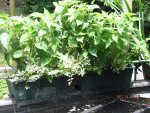Greetings!
I am interested in trying to incorporate some plants in a bog-like filter chamber as a portion of my pond filtration circuit. The idea would be that pond water would cycle through the container, in which plants potted in a minimal amount of gravel (individual containers) -- would reside with the plant roots completely submerged. I know this has been done by others before, but I am trying to gauge how effective this method might be.
My rationale is not so much to grow the plants themselves, but rather to allow for nutrient up-take by the plants, such that algae in my pond my have a harder time surviving. Plants could be thinned as needed.
I have done this once before with water lilies, but -- ironically -- the lilies required some compost and fertilizer for decent growth. While the lilies looked great, this planting method also added nutrients to the water (via the compost and fertilizer planting medium), which then also fosters algal growth.
I realize it seems elegant to consider plants as nutrient *sumps* to draw up nitrogen/phosphorus wastes produced by fish, but I really am not clear if the inclusion of plants can result in a significant improvement of pond water quality (e.g., no green-water algae, low nitrates) on a practical level in a normally bio-filtered pond? My intention would be to use plants which did not require supplemental nutrient sources beyond that provided by fish waste, such that plant growth could be expected to pull some dissolved wastes from the water.
If you have any experience trying this -- be it success or failure -- I would like to learn of your results.
Thanks for any replies.
I am interested in trying to incorporate some plants in a bog-like filter chamber as a portion of my pond filtration circuit. The idea would be that pond water would cycle through the container, in which plants potted in a minimal amount of gravel (individual containers) -- would reside with the plant roots completely submerged. I know this has been done by others before, but I am trying to gauge how effective this method might be.
My rationale is not so much to grow the plants themselves, but rather to allow for nutrient up-take by the plants, such that algae in my pond my have a harder time surviving. Plants could be thinned as needed.
I have done this once before with water lilies, but -- ironically -- the lilies required some compost and fertilizer for decent growth. While the lilies looked great, this planting method also added nutrients to the water (via the compost and fertilizer planting medium), which then also fosters algal growth.
I realize it seems elegant to consider plants as nutrient *sumps* to draw up nitrogen/phosphorus wastes produced by fish, but I really am not clear if the inclusion of plants can result in a significant improvement of pond water quality (e.g., no green-water algae, low nitrates) on a practical level in a normally bio-filtered pond? My intention would be to use plants which did not require supplemental nutrient sources beyond that provided by fish waste, such that plant growth could be expected to pull some dissolved wastes from the water.
If you have any experience trying this -- be it success or failure -- I would like to learn of your results.
Thanks for any replies.




